
A large canopy covers the Gobekli Tepe site, with visitors looking down from ramps. Photo by David DeVoss
By Jacqueline Swartz
From a hilltop vantage point with a sweeping view, visitors gaze down at a 12,000-year-old Turkish archeological site located in the foothills of the Taurus Mountains. In the past few decades, as new discoveries have been unearthed, archaeologists have been changing their views about the significance of the site. Among non-archaeologists, it’s another story: speculation about what the location represents has triggered both Netflix shows and New Age fantasies.
How were humans, five thousand years before Stonehenge, able to build such a massive communal site, with engraved pillars and semi-realistic carvings of the wild animals of the time – lions, snakes, gazelles and foxes?
Why are these finds, discovered only a few decades ago, considered to be so crucial to the history of humanity? For one thing, they show the origins of human history in the Neolithic age, thousands of years before the invention of pottery and writing. And they continue to raise questions about long-held assumptions. For instance, it was once thought that only settled agricultural societies could create culture, that only such communities could come together to build temples.
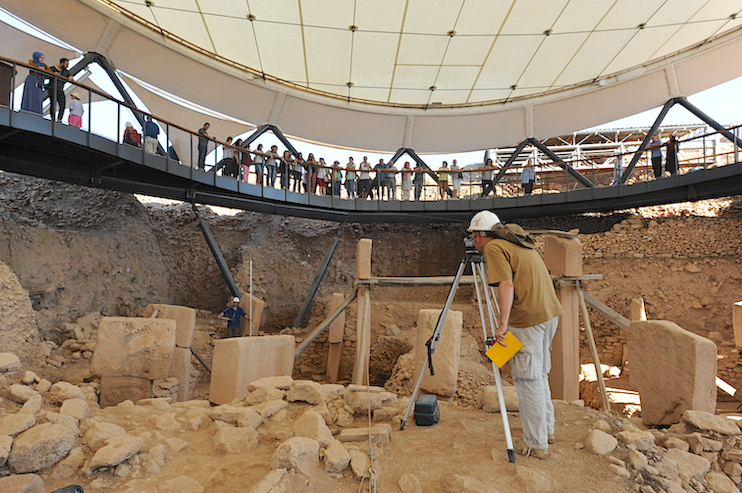
The site will be excavated for years, with much of it left buried. Meanwhile, new discoveries continue to change what we know about the hunter-gatherers who lived 11,500 years ago. Photo courtesy of Dr. Lee Clare, arkeofili.com
“Before we thought the people who built Göbekli Tepe were hunter-gatherers who began farming,” explained Turkish archaeologist Ahmet Yavuzkir, speaking to a group at the site. “We thought everything began with farming. This concept – that farming created modern civilization – was the basis for our historical assumptions. Now everything is reversed,” he said. “Hunter-gatherers built this site.”
With no farms or animal husbandry, what did these people eat? Wild animals like antelopes, wild boar, foxes, and aurochs—a now-extinct ancestor of the cow—were staples. So were wild grains – barley and wild oats, chickpeas and lentils. There could even have been beer, given the wild barley. But there is no evidence of planting.
Hunter-Gatherers or Settled Communities?
The either/or idea of settled communities versus hunter-foragers always on the move is now disputed. The site’s coordinating archaeologist, Lee Clare, believes that Göbekli Tepe was a place where hunter-gatherers spent time, benefitting from the seasonal abundance of a place on a migratory route for gazelles and surrounded by acres of wild grain.
The project, now a cooperative venture between the Sanliurfa Archeological Museum and the German Archeological Society, began in 1994 when German archaeologist Klaus Schmidt started unearthing megaliths and stone pillars. The project is relatively recent, compared to major discoveries like the Pyramids of Giza (c. 1830) or Ephesus (c. 1869).

Dr. Lee Clare, coordinator of research and fieldwork photographing a pillar in Building D. Unlike the other buildings, Building D has nothing relating to daily life. And yet it was not a temple in the usual sense. Photo courtesy of arkeofili.com
Since Klaus Schmidt’s findings, there has been much speculation and some far-out theories. One claims the area was the biblical Garden of Eden. No serious archaeologist agrees, but the internet is full of videos on this and other fantasies about Göbekli Tepe. Still, a Garden of Eden is easy to imagine. For in a kind of climate boomerang from the mini-ice age, this area, part of the Fertile Crescent, produced lush woodlands and grasslands, rivers, and fruit and nut trees.
World’s First Temple?
A more common notion is that it was the site of the world’s first temple. Klaus Schmidt believed this until he died in 2014. However, according to the project’s current coordinator, archeologist Lee Clare, the more recent discoveries of domestic tools and settings suggest that these hunter-gatherers did live there, most likely part-time. This was a domestic, not a sacred space. Still, the “first temple” theory gained traction, gaining publicity when Göbekli Tepe was designated a UNESCO World Heritage Site in 2018. The following year, the government of Türkiye declared “The Year of Göbekli Tepe.” This attracted tourists, and a visitor center was opened.
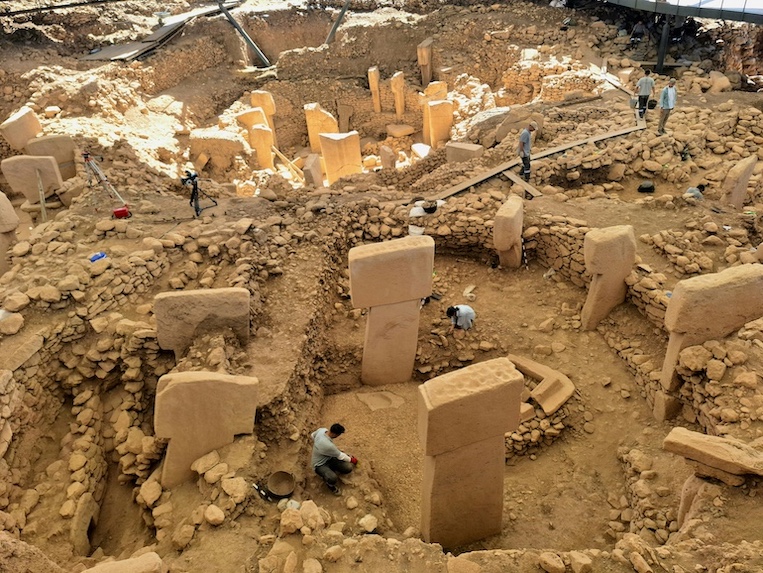
Many of the pillars at the site are placed in a circular position supported by a stone wall and surrounding two central pillars. They are made of limestone from a nearby quarry. Photo courtesy of arkeofili.com.
On-Site Visitor Center
Göbekli Tepe, now considered one of the world’s most significant Neolithic discoveries, demonstrates how tourism can coexist with archaeology. The visitor center, opened in 2019, includes a gift shop and café. But what is most striking – and valuable – is the round-shaped animation center. It explains some of the complex and controversial notions about the work of our prehistoric ancestors. There are interactive screens and stools for sitting.
Exiting the visitor center, you walk up a long ramp and gaze down at the site, which is protected by the dramatic flying saucer-shaped canopy. In the distance, there are the beige distant hills; far below, limestone enclosures surround the famous T-shaped megaliths, some as high as 18 feet. These are likely among the first such sites built by humans. It’s incredible, and inscrutable. Adding to this is the fact that different levels of Göbekli Tepe were buried and rebuilt, and the entire site was buried around 8,000 BC. Why? Archaeologists assumed that this was a practice of the time. Today, they point to the possibility of natural landslides, given the artificial hill on which the site stands and the heavy pillars it supports.

One of the most impressive limestone pillars found at the site, this one is decorated on three sides with reliefs of animals, birds and abstract forms. It demonstrates the work of skilled craftsmen. Photo copyright DAI (German Archaeological Institute), Gobekli Tepe Project.
There are now about a dozen similar sites in the region, all smaller than Göbekli Tepe, none of which have a visitor center. The major one, Karahan Tepe, located about an hour east, has drawn attention to its room, which features what are now identified as phallic pillars, with a scowling stone face emerging from a surrounding wall.
Sanliurfa Archaeological Museum
For anyone visiting Göbekli Tepe, the Sanliurfa Archaeology Museum is a must-see. Located about eight miles from the site, the museum is the largest in Türkiye. Spanning multiple periods up to the Ottoman era, it features an entire area dedicated to Goblekli Tepe. You can marvel at discoveries such as the megaliths, or pillars, and the carved wild animals that decorate them.
There’s a full-scale reproduction of what is called Special Building D, carbon-dated to around 9525 BC. Special Building D, unlike the other structures, has no items related to daily life – no grinding stones, for instance. Could this be a religious site? Archaeologist Lee Clare, who worked on the discovery of Building D, refuses to call it a temple. In a witty and informative video interview, he explains that the word is too close to contemporary notions of a religious site.
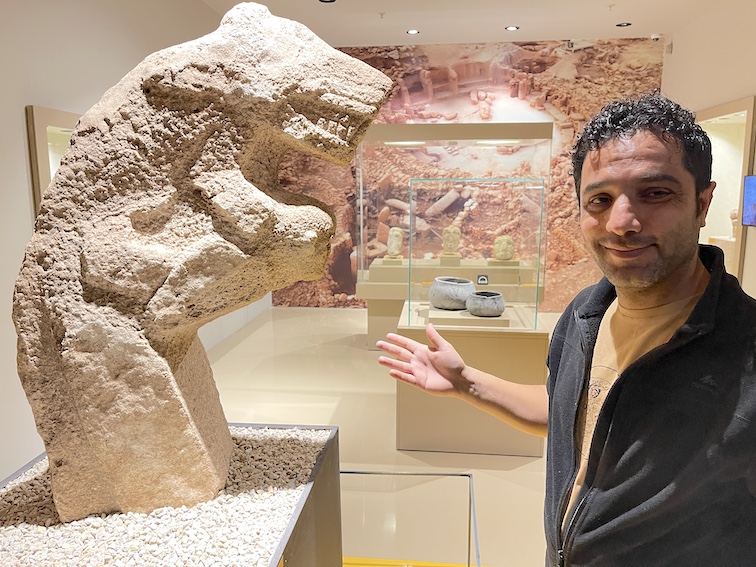
Archaeologist Ahmet Yavuzkir, Deputy Director of the Sanliurfa museum, with a statue of a wild boar, a striking discovery made at Gobekli Tepe in 2023. Photo by David DeVoss.
According to the German Archaeological Institute, the pillars, which are engraved with animals and what appear to be arms and handbags, could have been an abstract representation of men congregating. Women don’t seem to be represented anywhere – even the animals are male.
The site was likely used for communal activities, even rituals. According to Ahmet Yavuzkir, the archaeologist and deputy director of the museum, human deities weren’t worshipped, but perhaps animals or nature were. “This is where animistic and totemistic tendencies began,” he says.
One striking find, discovered in 2023 by Lee Clare in Special Building D, is a life-sized wild boar made of limestone, sitting on a table. It even has traces of pigment – red on the tongue, black on the body. In the museum, you can see it up close and ponder its purpose. Was it worshipped?
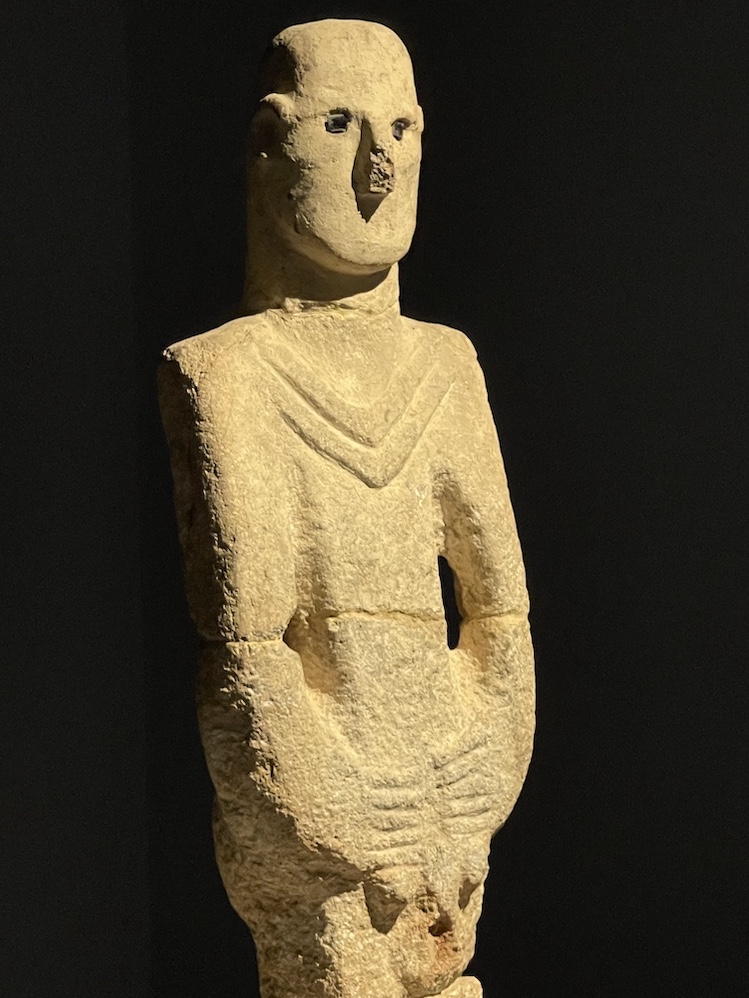
Urfa Man statue, 11,000 years old, considered the oldest life-size human statue. The eyes are obsidian and the hands cover the genitals. Photo by Jacqueline Swartz.
Another large sculpture on display in the museum was discovered not at Göblekli Tepe but accidentally, at a construction site in Sanliurfa, where the museum is located. The “Urfa man” dates back to 9,000 BC and is considered the first lifelike statue of a man ever made. It was found in 1993 by construction workers. No such statues have been found at Göbekli Tepe.
A Stop on the Silk Road
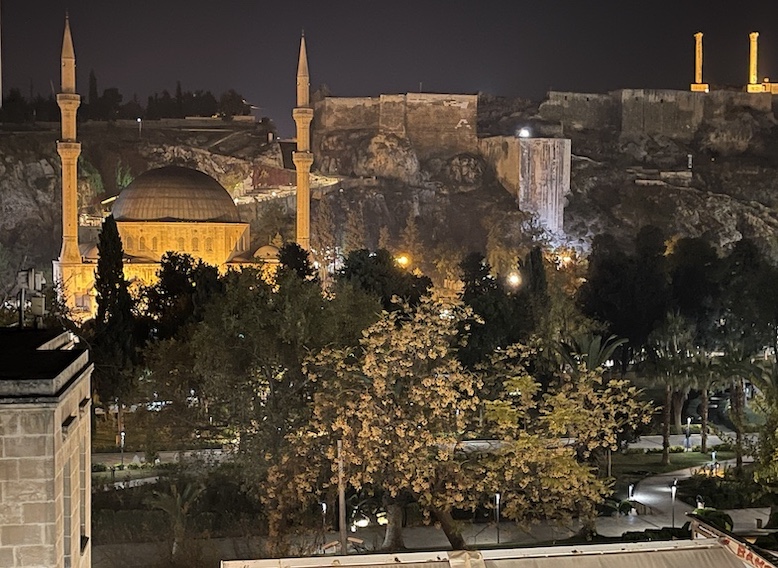
Urfa by night. Photo by David DeVoss
Urfa, the commonly used name for Sanliurfa, offers attractions that extend beyond archaeology. An hour and a half by plane from Istanbul, it is a vibrant place, much less touristy than Türkiye’s capital and other popular areas, such as Cappadocia. The Mesopotamian city features bazaars, markets, family-style restaurants and picturesque buildings, reminders that the place was a stop on the Silk Road. Located in Kurdish territory, you can hear Kurdish, Syrian and Arabic spoken, along with Turkish. Like Göbekli Tepe, this Ottoman-era town teases with its secrets. What was it like when caravans rolled through?
The most famous spot in Urfa is Balıklıgöl, also known as the Pool of Abraham. This is considered by Muslims, and to a lesser extent by Jews and Christians, to be the place where the Prophet Abraham was born. Thrown into the fire by Nimrod, the Assyrian king, Abraham was miraculously saved, according to legend, when the flames turned to water and the logs to sacred carp. This 150-meters long pool filled with fish draws thousands of locals and foreign tourists. Above the pool are the arches of the Rizvaniye Mosque, dating from the 18th century. Job, the story goes, is also from Urfa. Today, the city is still called the City of Prophets.
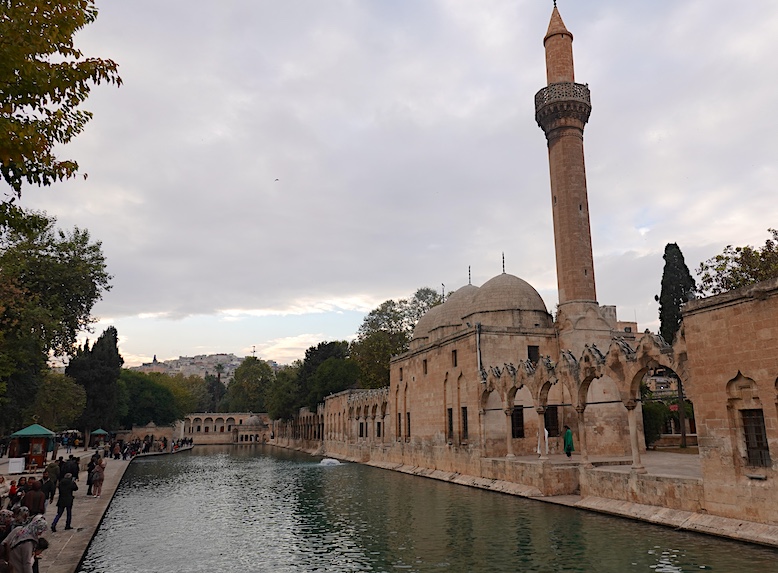
Balikligol Pool is one of the outstanding sites of Urfa. Here is where Abraham, the first prophet in the three Abrahamic religions, was flung, according to legend, onto a blazing pyre by Nimrod, the Assyrian king. Abraham was saved when God turned the flames into water and the burning logs into carp. The fish are thus considered sacred and are never caught. They are fed by pilgrims and tourists Photo by David DeVoss.
Sanliurfa Food
When it comes to food, Urfa has its own specialties. There’s a smoky, dried Urfa pepper, native to the area. Aleppo pepper, which is milder, and za’atar, a spice blend made from thyme, oregano, sumac and sesame seeds, are reminders that the place is about an hour and half drive from Syria. In the bazaars, you can see peppers, both fresh and dried, as well as spices like the lemony sumac and seasonal vegetables like eggplant.
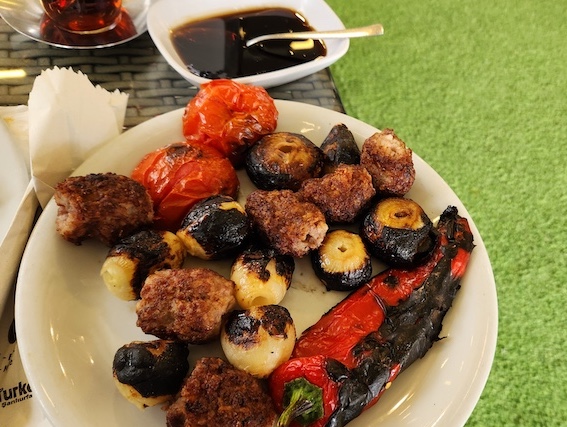
Urfa restaurants serve local specialties: lamb kebabs, eggplant and local spices. Photo by Jacqueline Swartz
The region is a major pistachio-growing site. With their high prices, no wonder pistachio nuts are called green gold. Pistachios are widely enjoyed in the area and bring the local baklava to a new level. They are present even in coffee. Menengic Kahvesa is a beverage that looks like Turkish coffee, but it isn’t. It’s made with ground terebinth, similar to pistachios. You can also get Turkish coffee topped with ground pistachios. The classic place to enjoy it is at Gumruk Han, a café located in a large courtyard at the end of Urfa’s central bazaar. Walking through the narrow, labyrinthine alleys, you’ll see merchants selling everything from copper to scarves, from spices to scent. Exit through the arch, and you’re in a large outdoor area filled with cafes and wooden benches. In Ottoman times, the Han was the center of the bazaar. Built in the late 1600s, this area was a stopover for weary merchants.
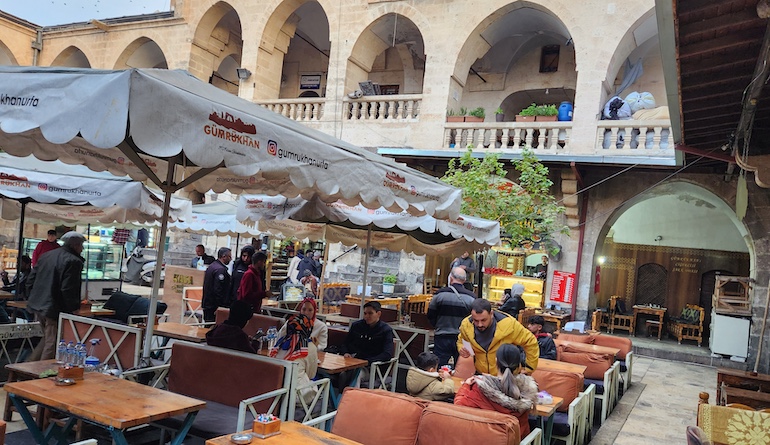
Gumruk Han Cafe. Built during the 16th century reign of Suleyman the Magnificent, it was once a place for weary caravans to stop for the night. Now it’s a large outdoor area where people sip coffee in cafes. Photo by David DeVoss
Kebabs rule in this part of Türkiye. They are grilled, baked and often stuffed with eggplant. For lunch, a good bet is Culcuoglu, a large, bustling place with beef and lamb kebabs, liver, and salads.
Porta Blu is a reasonably priced fine dining restaurant, done in a Turkish style with whimsical touches, such as drawings on the walls. There is an array of meze – seasoned yoghurt, dips, and salads, such as chopped arugula, cucumber, tomato, and onion, topped with pomegranate molasses, which is widely used in salads and sauces. And, of course, there are grilled meats – liver, beef tenderloin, lamb, and chicken.
Drums, Violins and a Bouzouki
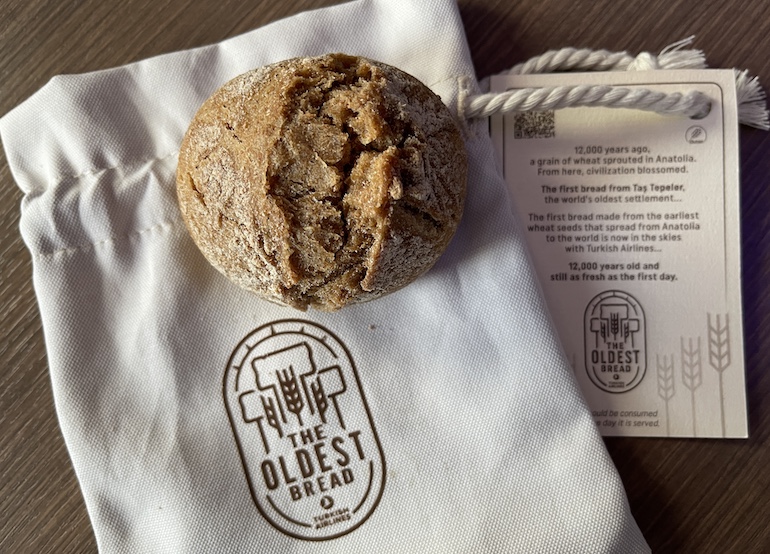
The inhabitants of Gobekli Tepe never ate bread like this being served in Turkish Airlines business class. But they did have wild grains, so perhaps they made flatbread. In any case, Turkish Airlines is celebrating the archaeological heritage of its home country that’s also renowned for its food. Photo by David DeVoss
A longstanding Urfa tradition is Sira Geces (Sira nights), an evening of food and music that takes place in numerous venues. At the colorful, atmospheric Alahlan Hotel, near the Balikligol pool, diners are served on long tables on both sides of the room. Then, a band plays traditional music on instruments like the baglama (a small bouzouki), oud, drums, and violin. This is a real Urfa evening, far from both modern times and the ancient mysteries of Göbekli Tepe.![]()
Jacqueline Swartz travels the world from her base in Toronto. Her most recent stories for EWNS examine Oklahoma’s Indian Nations and the City of Paris.

